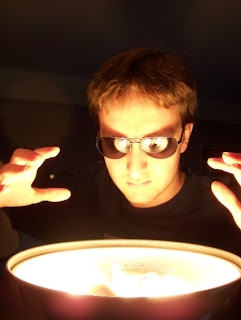 Areas is an abstract minimal 2D Flash-based shooter. The player controls a ship that fends off expanding white circles from filling the play space. The player completes each level by surviving for a set period of time: they lose if they are crushed by the circles.
Areas is an abstract minimal 2D Flash-based shooter. The player controls a ship that fends off expanding white circles from filling the play space. The player completes each level by surviving for a set period of time: they lose if they are crushed by the circles. Areas uses a no-click interface: the game is controlled solely by the position of the mouse, including all menu navigation and options. The reasons for this aren’t clear - the suggestion that it’s designed for playing on the Wii doesn’t hold up – but it’s probably artistic whimsy. It doesn’t quite work: there are moments when it screams out for a left-click (especially in the menus, which are unclear). However, it throws up an incidental quirk that alters the game from Geometry Wars and other similar two-stick shooters.
You control a cursor with the mouse. If the cursor is far from your ship, the ship approaches it a proportionate speed. At short range, the ship stops and fires towards your cursor. You can’t simultaneously move and fire. With a limited range of fire, the player must frequently consider whether to sacrifice firepower for position – the “difficult choice” that constitutes all gameplay.
2D shooters are about negotiating space. The movement and location of enemy fire defines locations you can’t go, and the smaller the safe areas are, the more likely you’ll be killed. They’re usually about controlling space too: destroying enemies creates new safe spaces, because bullets stop coming from that location. Usually everything is moving, so the player needs to think about where the safe spaces will be in the future.
In Areas, the only hazards are the relentless white circles that fill the play area (a much larger black circle). They appear randomly, and can only be checked by player fire. Contact with the circles is not fatal, and there are no lives: the player is only pushed back by the expansion. Many levels end with the player fending off the wall of white that approaches, while running the clock out. It’s genuinely claustrophobic.
Of course, with every enemy circular and expanding, it’s not obvious where the strategy in positioning lies. Enter the “magic circles”, areas left by destroyed circles that alter fire passing through them in various ways. Some split bullets in two; some expand bullets; some turn bullets into lasers, or rockets, or absorb bullets to power an explosion when they expire. But their effects combine: bullets may be enlarged, multiplied and then directed to the nearest circle. Under its frantic surface, Areas is a puzzle game. Most shooters are: spatial problems solved through vigorous gunplay. Some lie closer to puzzles (such as Ikaruga), while others lie closer to technicolour carnage (step forward, Robotron 2084), but all require a little thought to navigate with skill.
It's trying too hard to be an art piece, and it has a few balance problems, regarding its later levels and luck with the magic circles, but Areas is a game that demonstrates, more than a traditional example, what lies at the heart of the shooter.


